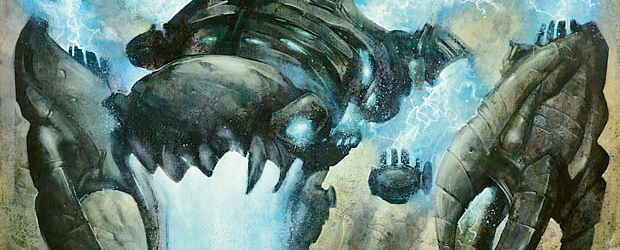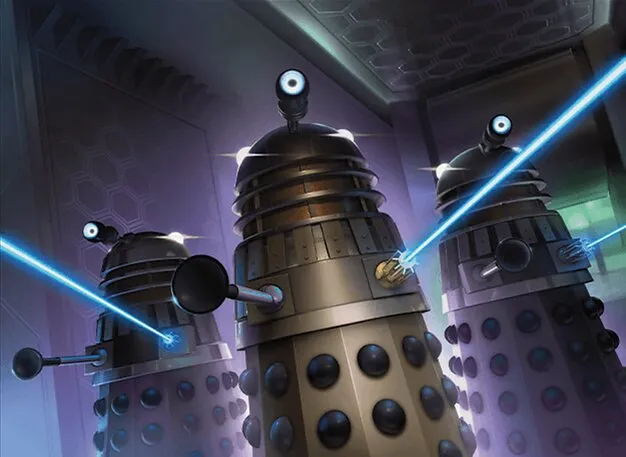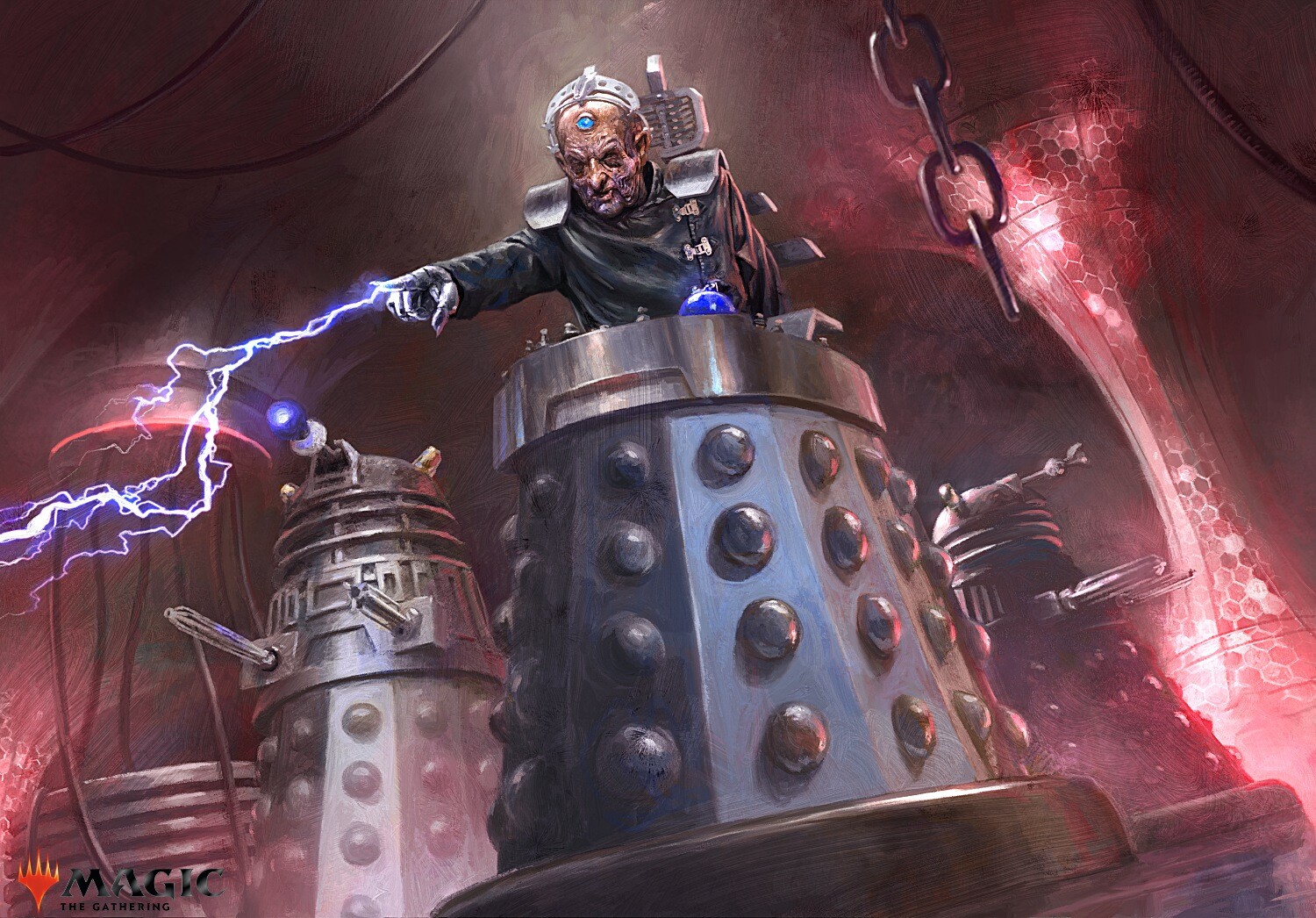The Pinnacle: Designing Monstrosities (Part 1)
Top creatures in magic the gathering
By Daniel Clayton – The Will of the Floral Spuzzem
Today I want to talk about some of the top creatures in magic the gathering as a whole, the most utilized and what makes them good; I’ll also try to pull some decks in and show just how good they are by their performance throughout the time since their printing. Some of the cards on this list are some of the most expensive cards in the game, while others are not quite as flashy. My requirement is that they are creatures and they have had some type of impact on the game at some point; while I will try my best to put the best creatures in the game on my list I am only human and as such make mistakes and I apologize if your favorite doesn’t make my list. As this is a type of card versus a specific card I figured I would drop them out in a top 6 list going from number 6 to number 1; I’ll also be pulling in some honorable mentions from throughout the years.
Honorable Mention
This card’s price correlates directly with the popularity of the Zoo deck archetype. This card costs only 1 to play, when it swings it gets 1/2 through its ability Exalted; this ability also makes anything else that swings alone grow bigger when it swings. The card is just an efficient mana producer that does a little bit more than just produce mana. This card acts as an outstanding piece of acceleration in general, accelerating both the amount of damage you’re able to get in and the amount of damage that you’re dealing each turn. While there are tons of decks that run this card, we’ll be looking into them a little bit later with a card later on our list. If you consider vanilla 1/1 elves that cost 1 and tap for 1 to be playable in any deck, you can see why this card just barely missed our list of most playable, but let’s keep the idea of mana producers going with the first cards on our list.
Number 6
Rofellos, Llanowar Emissary; and Metalworker
These two cards are some of the most powerful mana-producing creatures in the game, and they came out at about the same time as one another. The block that they came out in is called the Urza’s saga. It’s a saga about a war between 2 brothers and is filled with some of the most powerful mana producers in the entire game, it’s out of this set that you get such cards as Tolarian Academy, the Tron lands (Urza’s Mine, Tower, and Power Plant), and the two cards that we have here are the two best mana-producing creatures in the game. While Metalworker is a staple in Legacy and has seen some limited play in Vintage as well, with Rofellos being banned and restricted it does not have a deck it’s run in very heavily. As for why Rofellos is so good, it’s because the card essentially doubles your mana as soon as it comes down and it essentially doubles all the mana you play for the rest of the game. The card is so powerful that it almost warrants a kill spell the minute it hits play or the game quickly swings in the controller’s favor. The other card at number 6 is Metalworker and this card is so good that an entire deck archetype in legacy is based off of this card. The card is a powerful card coming out turn 2 in most cases and tapping for 6 to 8 mana if it survives to get to tap once. The card is run in Vintage stacks decks once in a while for its powerful mana acceleration turning the deck from a very gradual combo to set up into a much quicker set up for the lock. It’s run predominantly in the deck that carries its namesake, but it’s a powerful addition to any artifact deck. The style of this deck is as follows, this was a Metalworker that took 13th place in a Star City Games Invitational back in 2013.
MUD (Metalworker deck) Legacy decklist
The Metalworker deck is one of the most powerful decks in the entire game of Magic: The Gathering being able to stand on its own two feet in Legacy as well as Vintage and crushing decks in others formats easily. The deck works on the premise of getting expensive stuff out quickly and then cheating what’s too expensive to actually play. You typically want to get Metalworker out as quickly as possible with as many cards in hand as possible and then pump out a Lightning Greaves and a Kuldotha Forgemaster to try to get Blightsteel Colossus. You also try to pump up the cost for opponents to play spells through Lodestone Golem and Trinisphere. Additionally, cards like Steel Hellkite, Chalice of the Void, and Sundering Titan help to rip apart your opponents’ decks. Metalworker, Grim Monolith and Mox Diamond are your way to quickly pump up the Mana you need to wreck your opponents quickly. There are two combos that exist in the deck, the first is Staff of Domination, a card which can combo with Metalworker to give you an unlimited supply of card draw, mana, tapping, untapping and life; the second is Kuldotha Forgemaster, which lets you get out the most powerful cards in your deck in exchange for 3 artifacts. The card Lightning Greaves is a card which allows you to use creatures the first turn you play them both for using abilities and for attacking. The Goblin Welder is in your deck to deal with the mirror match and to also act as recursion for the deck. The Blightsteel Colossus acts as the win condition for the deck most of the time swinging in and winning the game usually at most by the second turn he comes out, but he is also the major beater for the deck. All of the lands in the deck serve as either a great mana producer or serve in a dual role doing something else on top of their original function. The Cavern of Souls acts not only as mana, but also to prevent your creatures from being countered. Ancient Tomb and City of Traitors strictly as a mana body, but in doing this they act as some of the best mana producers in the game. Darksteel Citadel and Great Furnace act not only as mana producers, but they are also artifacts meaning that they will add to Metalworker’s count and can be sacrificed for Kuldotha Forgemaster’s ability. Finally, I won’t get into Wasteland just yet (I have another article planned for that). The rest of the creatures, Myr Battlesphere and Wurmcoil Engine, are used as beaters with an edge. The edge for Myr Battlesphere is that he creates fodder for Kuldotha Forgemaster and both of the creatures help you to stabilize against typical agro strategies.
Number 5
Arcbound Ravager; True-Name Nemesis
If I were to give these 2 creatures a specific type, it would probably be unique; these are creatures that while they lend themselves to 1 strategy or another, they do not commit themselves fully to a strategy and it’s not the strategy that they lend themselves to that allows them to make this list. For True-Name Nemesis’s part, this is a true beater card, and through its ability to gain protection from target player this means that not only will the card gain evasion from that player’s creatures but also gains protection from that player’s spells making the creature very hard to kill. With a creature that is exceedingly hard to kill and has exceptional evasion, making it a 3/1 on top of everything else makes the card cream of the crop. It puts your opponent on a long but realistic clock of 7 turns that he can’t block; additionally, when you equip him with a sword or jitte the card’s clock count becomes ridiculously low for such a hard to kill card and you can count on the abilities to activate each turn making it even better. There are tons of True-Name Nemesis decklist on Three Kings Loot. Another of these unique cards is Arcbound Ravager, another of those cards that has a whole deck built around them. This card is again another beater, but it’s so much more than that and while it doesn’t win the game by itself it can be extremely hard to deal with. Its power however comes from its 2 abilities and this is what makes the card unique as well. The abilities that the creature has are the abilities to sacrifice an artifact to put a +1/+1 counter on Arcbound Ravager allowing him to protect himself from dying to spells or in combat. Additionally, if he manages to make it through without any blockers, being able to cash out all of your artifacts for +1/+1 counters can win you the game. On top of everything else, his second Ability, Modular means that you can also trade him to pass all of his +1/+1 counters to a creature that got through and potentially win you the game.
Affinity Modern Decklist
Some more Affinity decklists here.
If you are a player who plays in competitive Modern Tournaments at all, then you’ve probably played against this deck before and know that if you don’t have a way to counter it, it will probably cost you the tournament. This is a fast deck that has survived the bannings of 7 cards that I can think of off the top of my head (5 Colored Artifact Lands, Skullclamp, and Disciple of the Vault); even with all of these bannings the deck still remains a serious contender in almost all of the tournaments it makes a splash in. Most of your lands serve a double function whether that be getting blue (Island), Tapping for any color (Glimmervoid), acting as both an artifact and a mana source (Darksteel Citadel, Blinkmoth Nexus, Inkmoth Nexus), or serving as an alternate or additional win condition (Blinkmoth Nexus, and Inkmoth Nexus). Almost all of your creatures exist to pump up your artifact count and get in for some damage; the exceptions are Etched Champion (Yes, its primary idea is to get in for damage, but it does so reliably and has protection), Signal Pest (Pumping up all of the other cards swinging in), Steel Overseer (Making all of your guys larger), Vault Skirge (Its lifelink makes you able to compete extremely well against most other aggro strategies), and of course Arcbound Ravager himself (see above description). The Cranial Plating in the deck is your primary win condition, as it pumps up whatever it’s equipped to up to epic levels, and with the ability to re-equip at instant speed, the card can almost consistently guarantee that the damage is going to get in. The Mox Opal and Springleaf Drum act as some pretty impressive mana acceleration and can win you a whole game almost without having to worry about drawing lands. The Thoughtcasts typically come down for 1 mana meaning that you get to draw two cards for next to nothing. This deck leads me up to our next honorable mention, however, and that is:
Honorable Mention
A completely broken card when it first came out; it earned itself a banning in both Standard and Modern for a time for its power. This is a 1/1 creature for 1 Black mana that makes an opponent lose life each time an artifact is put into the graveyard, when this card first came out in Mirrodin (a largely artifact block, it warped the game in Standard so heavily that everyone was playing a variant of this deck leading to this card’s banning). This card is still chosen as the card of choice in some Vintage Brews that brag about turn 0 victories (That is to say, winning the game before you take your first turn). While I would post some of these decks up here, they’re not exactly what I would call competitive deck lists and as such I’ll just run through the major strategy of the deck and you can build your own or look it up if you feel so inclined. The deck runs cards such as, Gemstone Caverns; this is a card that allows you to put it directly into play with a luck counter on it if it’s in your opening hand. On top of this it runs Protean Hulks and Flashes (Protean Hulk is a creature that says that when it is put into a graveyard from play you may search through your library for creatures with total converted mana cost 6 or less and put them into play). Finally, the deck runs Disciple of the Vaults and any number of Artifact creatures that enter play with a number of +1/+1 counters equal to the X that you spent to cast them (At least 5 of these). Now the strategy typically works like this, on your opponent’s upkeep, you get out Gemstone Caverns and 1 more mana in some way to cast flash on your opponent’s first turn, you cast flash putting out protean hulk and you let it die, allowing you to search through your deck for your 4 Disciple of the Vaults and all of your 0/0 artifact creatures (they become 0/0’s since they have no +1/+1 counters); all of these cards hit the field at the same time, then all of the 0/0’s die and are put into the graveyard resulting in your opponent losing 4 life for each one that does (because of the Disciple of the Vaults). The deck achieves what is considered impossible for most decks, but with the combo being very hard to establish and easily pulled apart by counters the deck is not very playable; still Disciple of the Vault plays into its spot as one of the most powerful combo creatures of all time.
Number 4
Kiki-Jiki, Mirror Breaker; Stoneforge Mystic
These 2 cards come off as incredibly powerful combo creatures… well at least one of them does and depending on your point of view so does the other. Stoneforge Mystic is the card that is left in question when it comes to combo creatures sitting at this number, and while it does indeed contribute itself to other things I like to think of it as a combo card in itself as much as Tooth and Nail could be considered a combo card. Just like the card Tooth and Nail, Stoneforge Mystic will search through your library for you and pull potentially one of the best cards in the entire game from it and add it to your hand, then for an additional cost it offers to put that card onto the field; the kicker to the whole thing is that the card lets you keep effectively “cheating” an equipment into play meaning that the card combos nicely with Batterskull. This card has been a true contender ever since its first appearance earning it a banning in both Modern and at its time Standard. Stoneforge Mystic stills rules the tournament scene however making a powerful appearance in Legacy tournaments. Check out Three Kings Loot for some of the latest Stoneforge Mystic decklist. The other side of this creature combo type is Kiki-Jiki, Mirror Breaker, who sits atop every Timmy’s dream of infinite creatures. This card or its mirror in Splinter Twin coupled with enter the battlefield abilities makes this card one of the most combo-able and powerful creatures ever created. The card just screams win and has proved this point through the many prestigious tournaments it has under its belt. Recently there has been a decklist based around this card that has caught my eye, Kiki Angel:
Kiki Angel Modern decklist (UWR control)
More kiki-jiki decklists here.
This deck looks really cool and powerful and feels a little bit different from your usual Splinter Twin deck (More powerful? Probably not, but it’s fun to get out there and try new things every once in a while). There are a whole bunch of variations out there and if you’ve got a little bit of extra time and cash you could try putting one together and see how it feels. The lands in this deck pretty much do what there suppose to do, generating mana or searching for other lands. This deck has two combos centered around Kiki-Jiki, the first involves putting him into play then getting Restoration Angel online and using each new copy to blink Kiki-Jiki allowing him to create infinite copies of Restoration Angel. The second involves playing Kiki-Jiki, then Deceiver Exarch and using Kiki-Jiki to create infinite copies of Deceiver Exarch through his enter the battlefield ability. Snapcaster Mage allows you to gain extra resources by giving an instant or sorcery in your graveyard flashback. Finally, Geist of Saint Traft (Actually the weakest card in the deck, it just doesn’t work well with the strategy) just basically acts as a distraction and a beater running in and trying to deal some damage each turn. The instants in the deck fall into 1 of 2 categories, you have the first half which deal with creature destruction giving you more time against more aggro decks and mirror or similar decks (Path to Exile, Izzet Charm, Lightning Bolt, and Lightning Helix), and you have the counter spells to give your combo some protection (Mana Leak, Izzet Charm, and Remand).
In this Article we’ve gone and talked about creatures numbers 6 through 4 and some decks that they exist in that done fairly well in over the years. To give a little review, at number 6 we had our super mana-producing creatures (Rofellos, Llanowar Emissary and Metalworker) and the deck was a powerful and fast deck, Metalworker (MUD). Sitting at number 5 we went over our unique creatures (Arcbound Ravager and True-Name Nemesis) and the uniquely difficult decks that they exist in. Finally, sitting at number 4 is our combo creatures (Kiki-Jiki, Mirror Breaker and Stoneforge Mystic) and the powerful creation in Kiki Angel (My name for it… I think) also known as Kiki Control a variation of UWR control in Modern. In the next article, we’ll hit numbers 3 through 1 and try to find out what the best creature in the game is… well the best one in my opinion anyway.
Tip of the Spuzzem: Casual Encounters
I do apologize to my fellow and senior writer on this site for borrowing the name of his column (Bruce Gray), but it was just such a brilliant name that I couldn’t pass it up for this sub-article. A lot of times I have ideas for articles that are definitely on the shorter side so I’ve decided to write these articles in a sub-article of my articles called Tip of the Spuzzem. In this article I just want to talk about a problem I see with a lot of players and sort of give my perspective on how to fix the problem. The problem I’m talking about is how a lot of players put the game on a pedestal especially in the lower upper echelon of play and treat it as something more than what it is; that is to say more than a game. Once you reach a certain level of play (or your cards reach a certain value, I should say) it stops becoming a game to some player and becomes something else entirely, I’m not sure quite what… but not a game that’s for sure. This is a bad trend that players need to avoid for a lot of reasons, but the most prominent is the fact that most of these players become really unaccepting of newer players and shun them from real play for one reason or another. You see this all the time, players rushing new players in play or groaning when they make a mistake. You see it when a player loses and blames their loss on luck or bad draws versus throwing up their hands and saying, you know what maybe I screwed up on that last play I should do it this way instead next time, or refusing to look or talk to you after you beat them. Well it comes out as a bit more rambling than I had intended, but yeah it’s a serious problem and it can have a serious impact on driving new players from the game.
The solution to this problem is a really easy one; simply turn the game into a game again, and this isn’t an especially hard feat. It comes with taking the game a little less seriously, playing some tabletop games with your friends every once in a while, but most importantly, designing and playing with a casual deck. Now casual doesn’t mean bad, you can design a pretty powerful casual deck, just make the deck do wacky things that you think are fun (but not necessarily good); for me, my casual deck is a Green Defender deck that gets insane amounts of mana and then goes off and puts most of the cards in my deck into play through Genesis Wave. The deck is powerful, but the choice of cards in the deck makes it illegal for tournament play without a lot of changes and honestly I don’t want to make those changes, I like the deck the way it is. Another solution is avoiding other players/friends with “toxic” personalities; these are the players that get easily fed up when someone doesn’t understand the rules when playing for fun. This also refers to players that would much rather sulk following a loss in a match versus picking back up and shuffling up. To make a long story short, just remember Magic is a game and if you’re using it for any other reason than to have fun, you’re probably doing it wrong, and when you stop doing Magic right typically it’s not too long before you get out of the game altogether.
By Daniel Clayton – the Will of the Floral Spuzzem @Dc4Vp On twitter












